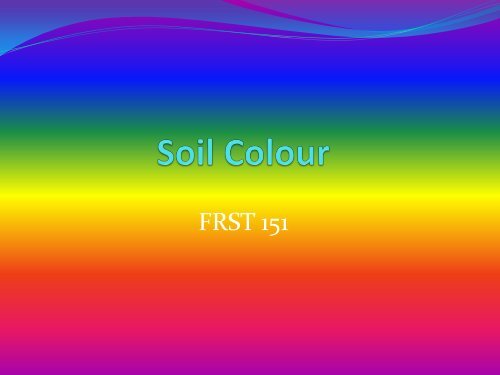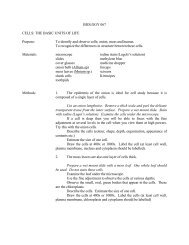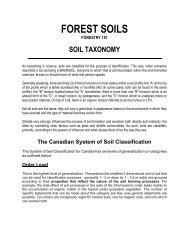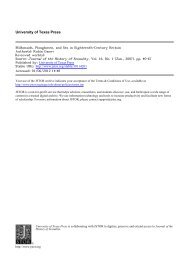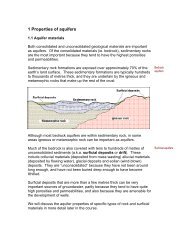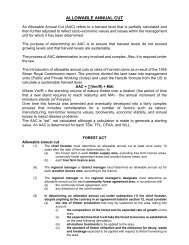Create successful ePaper yourself
Turn your PDF publications into a flip-book with our unique Google optimized e-Paper software.
FRST 151
<strong>Soil</strong> <strong>Colour</strong><br />
After texture, soil colour is the most significant and<br />
important physical feature. From colour we can conclude<br />
a number of very important soil attributes including…<br />
• How well the soil allows gases and water to flow<br />
• The extent of chemical weathering that goes on<br />
• The soil’s overall productivity
<strong>Soil</strong> <strong>Colour</strong><br />
Most soils have a fairly bland dark grey<br />
colour as a parent material but changes over<br />
time as a ƒ of:<br />
Parent material type<br />
% of organic matter content<br />
The amount of eluviation and/or<br />
illuviation that has occured<br />
The extent of oxidation and/or reduction<br />
that has taken place and the amount of<br />
oxides accumulation in the soil<br />
Red colours are due to the presence of Fe +++<br />
or ferric compounds and indicate that the<br />
soil is well aerated.<br />
Yellows signify intermediate aeration.<br />
Blue & grey colours indicate poor aeration<br />
and are due to ferrous compounds (Fe ++ ).<br />
Eluviated “A” horizon over a reddish<br />
“B” horizon typical of a Humo-Ferric<br />
Podzol
<strong>Soil</strong> <strong>Colour</strong><br />
Reddish colours indicate the presence of Ferous (Fe ++ )<br />
compounds and indicate that the soil is generally well<br />
aerated.<br />
Blue – Grey colours indicate the presence of FERRIC<br />
(Fe +++ ) compounds that are often associated with<br />
reducing conditions (anaerobic bacteria) and poorly<br />
aerated soils.<br />
Yellowish soils signify an intermediate state of aeration.
An other way of looking at it…<br />
Mottles are spots or blotches<br />
that are different from the matrix<br />
or background colour – they are<br />
usually red to orange and result<br />
from reducing conditions – poor<br />
aeration usually due to flooding or<br />
saturated conditions.<br />
Loss of electrons is oxidation and gain of<br />
electrons is reduction<br />
“LEO says GER”<br />
Fe +++ (ferric) Fe ++ (ferrous)
<strong>Soil</strong> <strong>Colour</strong><br />
To ensure that colour deffiniton is consistent, the<br />
Munsell <strong>Colour</strong> Notation is used. This standardization<br />
system was developed by …<br />
Albert Munsell in the early 20 th century<br />
and is used by all soil scientist as the basis of soil colour<br />
classification.<br />
Munsell broke down colour into 3 parameters…<br />
Hue, Value, and Chroma.
Using the Munsell <strong>Colour</strong><br />
Notation standardizes<br />
colour description.<br />
<strong>Colour</strong> Coding<br />
USDA<br />
Handbook #18
Munsell <strong>Colour</strong> Chart
Hue, Value, Chroma<br />
The system recognizes 5 dominant<br />
colours with 5 additional “half way”<br />
colours such as yellow-red. These are<br />
referred to as the Hues.<br />
The Value describes the brightness<br />
of the colour from black (0) to white<br />
(10) and 5 being neutral grey.<br />
Chroma is a measure of “purity” or<br />
strength of the colour on a scale from<br />
0 (weak) to 12 (very strong) –<br />
although the later only applies to<br />
some colours.
On the scale, 10R is very strongly red; from there, the<br />
colours degrade down to pure yellow with a code of 5Y<br />
(10R ->2.5YR ->5YR ->10YR ->2.5Y -> 5Y)
<strong>Soil</strong> <strong>Colour</strong> & Moisture<br />
<strong>Soil</strong> colour is strongly affected by moisture.<br />
As such, it is important to specify colours as either<br />
wet, moist, or dry.
Reading the Chart…<br />
Each of the 5 Munsell colours are divided into 10 subdivisions<br />
to allow for “merging or compound” colors.<br />
The Munsell <strong>Colour</strong> Code: 7.5 YR 5/6 – Strong Brown. When<br />
identifying a colour in the Munsell colour book, read the Hue<br />
in the top right hand corner of the page followed by the value<br />
on the inner vertical side of the page followed by the chroma<br />
on the lower horizontal side.<br />
Newer Munsell Books have a section specifically designated for<br />
“Gleyed” soils.
Mottling<br />
Mottling is a blotchy colour<br />
condition in the soil that is<br />
indicative of less than perfect<br />
drainage but not as imperfectly or<br />
poorly drained that the blue/grey<br />
colours indicate.<br />
Mottles tend to be reddish in<br />
colour and stand out against the<br />
“matrix” colour of the soil.<br />
Mottles are defined in terms of<br />
their - abundance<br />
- Size<br />
- colour<br />
- colour contrast to the<br />
matrix<br />
SOIL MOISTURE CLASSIFICATION<br />
Generally, for forestry purposes, soil moisture is merely described as<br />
either dry, fresh, moist, or wet. However, at a more extended level,<br />
soil moisture can be classified as...<br />
RAPIDLY DRAINED: No mottling or gleying is found<br />
throughout the profile or found on steeper slopes.<br />
WELL DRAINED: <strong>Soil</strong>s is generally free of mottling within<br />
the upper meter to the soil surface.<br />
MODERATELY WELL DRAINED: <strong>Soil</strong> is often faintly<br />
mottled in the lower B and C horizons and the C horizon<br />
can be gleyed.<br />
IMPERFECTLY DRAINED: <strong>Soil</strong> is often distinctly mottled in<br />
the B and C horizons but can also be gleyed.<br />
POORLY DRAINED: <strong>Soil</strong> is usually strongly gleyed. <strong>Soil</strong> is<br />
saturated for most of the year.<br />
VERY POORLY DRAINED: <strong>Soil</strong> is strongly gleyed, free water<br />
remains at or within 30 cm of the surface most of the year.<br />
<strong>Soil</strong> drainage is a function of slope, slope position, texture, depth of<br />
soil, water table, field capacity, and infiltration capacity.
Gleying<br />
Gleying is the extreme outcome or<br />
result of reduction by anaerobic<br />
bacterium.<br />
These bactirum do not use oxygen<br />
but a process called electron<br />
transfer respiration – they use the<br />
electrons from Fe ++ (ferrous iron) for<br />
energy and create Fe +++ (ferric iron)<br />
in the process.<br />
In this case the soil develops a blue<br />
grey colour.<br />
<strong>Soil</strong>s that develop this colour are<br />
usually saturated for prolonged periods<br />
of time during the year.<br />
Blue grey colours typical of the<br />
Gleysolic order


